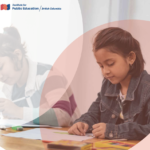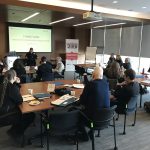Perspectives is an opportunity for Fellows and others to share their ideas in short, accessible essays. IPE/BC Fellows hold a range of views and interests relative to public education.
Public School Programs of Choice: Private school in the public system?
by Tara Ehrcke
The 21st century has, so far, seen the great up-ending of one of the most fundamental tenets of public education—that all children, regardless of background or socio-economic status, should be able to reach the same educational end goal. This concept of equality of outcome was intricately tied to the notion that society provided, or should provide, for social mobility. One could improve one’s station in life because public institutions, such as public education, were grounded in what we would now more commonly refer to as equity. The system, rather than doling out resources equally to all children, would rather apportion them so as to ensure that those starting with a disadvantage had the opportunity to catch up.
The neoliberal turn of the late twentieth and early twenty-first century has instead brought us back to the more basic and enduring features of capitalism. Institutions, rather than mitigating inequalities, are instead exacerbating them. Within schooling, this obviously takes shape clearly in the private versus public provision of schooling. But, even within the public school system, a great many features serve to further stratify children according to race, class and gender. We see aspects of private schools directly within public schools.
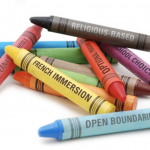 One such feature is school choice. “Choice” takes place in a variety of ways: the open catchment areas; allowing and increasing public funding of private schools; allowing school fees; and promoting niche schools and academies. With only limited opposition (from parents, teachers and school trustees) “choice” policies have changed the nature of BC’s public school system. The impact of these changes is that we are moving from a more comprehensive, equitable, neighbourhood and community oriented, publicly administered school system, towards a semiprivate, stratified and segregated system in which precious limited resources are increasingly allocated to a privileged minority.
One such feature is school choice. “Choice” takes place in a variety of ways: the open catchment areas; allowing and increasing public funding of private schools; allowing school fees; and promoting niche schools and academies. With only limited opposition (from parents, teachers and school trustees) “choice” policies have changed the nature of BC’s public school system. The impact of these changes is that we are moving from a more comprehensive, equitable, neighbourhood and community oriented, publicly administered school system, towards a semiprivate, stratified and segregated system in which precious limited resources are increasingly allocated to a privileged minority.
Parents can be easily swayed by these calls: How could school choice be a bad thing? How is wanting the best for my child making things worse for public education?
Teachers, administrators and school board trustees can similarly be entranced by school choice initiatives. They see opportunities to offer new and alternative programs that otherwise wouldn’t be supported. Or more likely, they see their existing programs cut and school choice policies the only method to try and maintain them. With fee structures, they see the chance to have properly funded programs. With dwindling support and resources from the basic Ministry budgets, these policies can appear to be the only way to keep such programs running.
But sometimes what seems or even is best for one child or one group of children is not best for all children. And what appears to be saving an individual program is in fact fundamentally changing the nature of the school system.
School choice exists in British Columbia in a variety of forms. All catchment boundaries are now open, or semi-open, allowing parents to register in a school outside their catchment area. French immersion, perhaps the longest running, largest, and most entrenched program of choice, is now commonly known as “the private system within public schools.” Immersion programs are notoriously unfriendly towards struggling learners. Children with challenges typically cannot receive special education services in French, and are often advised to switch back into the English stream.
 Yet another form of school choice is the Academy, or niche program. There are sports academies, and arts academies, but also academic academies such as International Baccalaureate programs, honours programs, and challenge programs. These
Yet another form of school choice is the Academy, or niche program. There are sports academies, and arts academies, but also academic academies such as International Baccalaureate programs, honours programs, and challenge programs. These 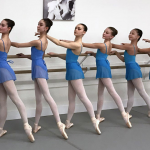 specialty programs often have competitive enrolment processes, and often require the payment of school fees (typically $2000 – $5000, but as much as $17,000/year). Thus, they are available only to a small subset of students.
specialty programs often have competitive enrolment processes, and often require the payment of school fees (typically $2000 – $5000, but as much as $17,000/year). Thus, they are available only to a small subset of students.
Data from the Vancouver School Board verifies the low number of students with an IEP, who are English Language Learners, or who are Aboriginal within the Vancouver Board school choice programs.
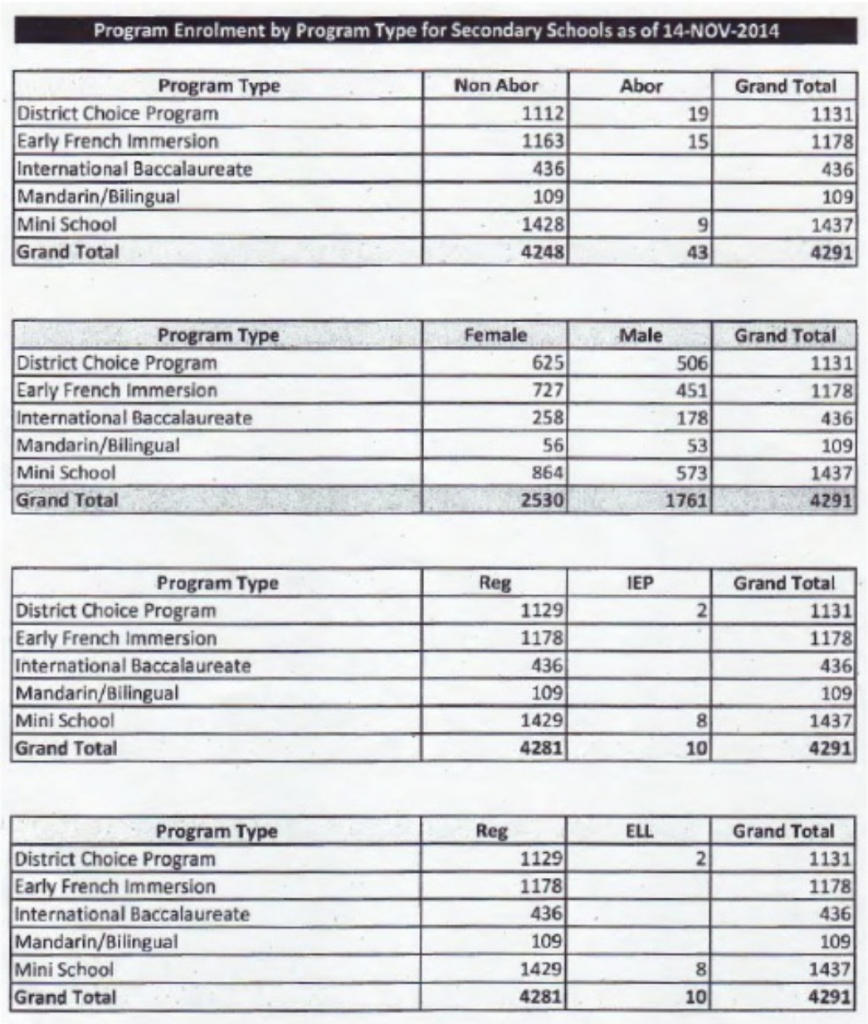
Source: VSB, Freedom of Information request number 201425
Research on school choice programs generally finds that access to choices varies in relation to socioeconomic status, and that choice tends to have the effect of stratifying along socioeconomic lines. Parents who have more social capital will exercise their rights to choose. They are the ones able to pay additional fees, drive across town, or wait in overnight lineups. Often, they are simply the parents who know about the choices and the ways to access them.
When these parents access special schools and programs, they are choosing a demographic that matches their own, and thereby reducing the diversity of the schools and programs they have left.
Even the rather conservative Organization for Economic Cooperation and Development (OECD) acknowledges what the research shows:
“School choice advocates often argue that the introduction of market mechanisms in education allows equal access to high quality schooling for all. Expanding school choice opportunities, it is said, would allow all students – including disadvantaged ones and the ones attending low performing schools – to opt for higher quality schools, as the introduction of choice in education can foster efficiency, spur innovation and raise quality overall. However, evidence does not support these perceptions, as choice and associated market mechanisms can enhance segregation. … Although parents may be concerned about equity and integration and may support their neighbourhood school, they seek at the same time the “best” education for their children… Parents with a better off background tend to avoid schools with a significant number of disadvantaged students and research suggests that parents prefer schools with populations ethnically similar to their own family… All these elements contribute to socioeconomic segregation between schools.”
A genuinely public school system includes equal opportunity for all members of the public. Schooling must be common, collective and universal; equity must be a guiding principle.
To restore equity in public schools, we should focus on these goals:
- Advocate for fully funded comprehensive neighbourhood schools with a full range of programming at every school, available to every child
- Eliminate school choice policies including open catchments, niche schools/programs, program fees, and streaming
- Eliminate all private funding: subsidies to private schools, fundraising, corporate and other private donations, and school and program fees
A longer version of this article published in Our Schools, Our Selves is available here.
Tara Ehrcke is a high school math teacher in Victoria and Past President of the Greater Victoria Teachers’ Association.
